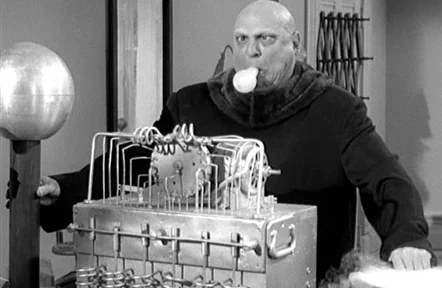Right now, all around your body, you are producing electricity. It’s not enough that you can stick a light bulb in your mouth and have it light-up à la Uncle Fester…
…but still, little electric currents are continuously happening inside of you, and that is keeping you alive.
All living things, from bacteria to blue whales, produce electricity to stay alive. You couldn’t stick a light bulb in a blue whale and have it light up either, but you can get bacteria to light up a light bulb. How do I know this? Because, right now, bacteria are making a light bulb flash in my basement. It looks like this:
You can get bacteria to do the same thing at your house. I will be writing about that in my next blog post.
In the meantime, what do I mean when I say you are generating electricity? Does this mean you are on your way to developing electric superpowers and soon you can start battling crime as a superhero named the Human Electric Outlet?
Sadly, no, but what is happening inside of you is still cool. Electricity is basically what happens when electrons escape their atomic prisons. Atoms are the ridiculously tiny things that make up the universe. As tiny as atoms are, they are made up of even tinier particles, some of which are called electrons. Electrons are the particles on the outer edge of an atom.
Atoms hold onto their electrons pretty tightly, but sometimes these electrons get loose. That’s when the phenomenon we call electricity occurs. If electrons escape and are just hanging around looking for something to do, we call that static electricity. You can make electrons escape to create static electricity right now (Well, you can if you have a balloon with you that you can rub on your head for a few seconds. The balloon will rub electrons off your hair, which will then make your hair stand on end.)
Is this girl a member of the band The Cure? No! She looks like that because sliding down a plastic slide rubbed a bunch of electrons off her hair and created static electricity.
Escaped electrons usually don’t stay loose very long, because certain things naturally pull electrons towards them. When this happens, the electrons line up into a moving parade that we call an electric current. Every time you turn on a switch in your house, you are allowing a parade of electrons to flow through an electronic device. This electric current gives the device the energy it needs.
Your body also needs energy to do everything it does, from blinking to thinking to armpit stinking (that would have been more accurate if I had written “sweating,” but then it wouldn’t have rhymed). We would not get the energy we need to do this stuff if it was not for electrons flowing through our cells.
To get electrons to flow through our cells, we need to do two things: eat and breathe. One of the reasons we eat is because food contains stored energy, usually in the forms of sugars and fats. Your blood carries these sugars and fats to your cells. Inside each of your cells, the sugars and fats are broken down through a series of chemical reactions until electrons are released. In order to get the electrons to produce energy in our cells and not just hang out there all the time, something has to make them move as a current. That something is oxygen. When oxygen shows up in a cell full of loose electrons, its kind of like the oxygen is Justin Bieber and electrons are a bunch of teenage fans in Oslo. The electrons all run towards the oxygen as fast as they can. When they do this, they create a current that completes the chemical reactions that give our cells the energy they need to do stuff (scientists call this type of energy ATP). This is the reason we need to inhale oxygen all the time. We need the oxygen in our bodies to act as a magnet to move and collect loose electrons so we can get the energy we need to survive. All multi-cellular organisms breathe oxygen for this purpose (yes, including plants).
Not all microbes do this, though. Some microbes live in places where there is no oxygen (like the seafloor), and they have to breathe other things, like, and I’m not making this up, rocks, to get the electrons moving in their cell so they can get the energy they need.
Because microbes are diverse in how they move electrons, scientists have figured out how to use some of these microbes as batteries, including microbes that you could collect outside your home right now. I will tell you how you can do this and how you can make your own battery with microbes in my next post.
P.S. Your nerves and muscles also produce electricity, but it is a different kind of electricity than what is happening in your cells, because it depends on producing charged ions instead of electrons. You can’t recharge your iPad with electricity from charged ions, but you can with electricity from flowing electrons.
To learn more about microbes and how they produce electricity, read my free eBook Where Wild Microbes Grow.
Online references and resources
Brightstorm. "Cell Functions and Processes." Videos.
https://www.brightstorm.com/science/biology/cell-functions-and-processes/
The Medicine Journal. "How the Human Body Creates Electricity."
https://www.youtube.com/watch?v=1-NA86aAMvY
PBS. "Suffocating cells for science."
http://www.pbs.org/newshour/updates/suffocating-cells-science/
Photos and Images
Click the photos and images used above to find their sources (Except the GIF. I took that).


